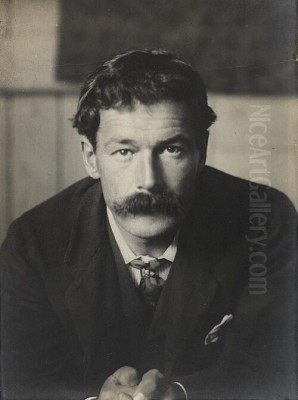
Henry Scott Tuke stands as a distinctive figure in British art history, bridging the late Victorian and Edwardian eras. Born in York on June 12, 1858, and passing away in Falmouth on March 13, 1929, Tuke carved a unique niche for himself primarily through his evocative depictions of male youths, often nude, set against the sun-drenched coastal landscapes of Cornwall. A painter associated with the Impressionist movement and a key member of the Newlyn School, Tuke was also a capable photographer and occasional poet. His work, celebrated for its mastery of light and colour, particularly in rendering sunlight on skin and water, navigated complex social terrains during his lifetime and continues to provoke discussion and admiration today, holding a significant place in both maritime art and LGBTQ+ cultural history.
Early Life and Artistic Formation
Henry Scott Tuke hailed from a prominent Quaker family in York. His father, Daniel Hack Tuke, was a distinguished physician specializing in mental health, co-authoring the influential "Manual of Psychological Medicine." This background, emphasizing social conscience and intellectual pursuits, likely shaped the young Tuke, although his path diverged towards the arts. The family relocated to London in 1870, which provided Henry with greater opportunities for artistic training.
He enrolled at the prestigious Slade School of Art in 1875, studying under influential figures like Alphonse Legros and Sir Edward Poynter. The Slade, known for its emphasis on drawing from life and its relatively liberal atmosphere compared to the Royal Academy Schools, provided a solid foundation. Tuke proved a promising student, winning a scholarship that enabled him to travel and study further afield.
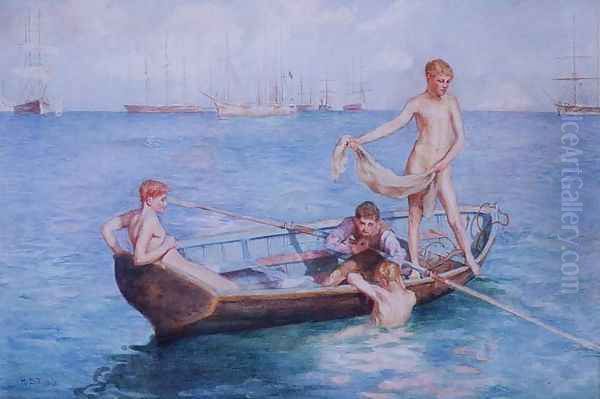
Following his time at the Slade, Tuke spent time in Italy in 1880, absorbing the lessons of the Old Masters. More significantly for his stylistic development, he then moved to Paris from 1881 to 1883. There, he studied under the history painter Jean-Paul Laurens and encountered the burgeoning trends of French Realism and Impressionism. He was particularly influenced by the plein air (open-air) approach advocated by artists like Jules Bastien-Lepage, whose emphasis on natural light and contemporary rural subjects resonated deeply with Tuke's own inclinations. During this period, he also formed connections with other artists, including the American expatriate John Singer Sargent, whose painterly bravura may also have left an impression.
The Newlyn School and Falmouth Years
Upon returning to Britain, Tuke initially settled in Newlyn, a fishing village on the Cornish coast that was rapidly becoming a magnet for artists seeking authentic, unvarnished subjects and dramatic coastal light. He became associated with the Newlyn School, a group of artists committed to plein air painting and depicting the realities of rural and coastal life. Key figures included Stanhope Forbes, often considered the group's leader, Walter Langley, Frank Bramley, and Thomas Cooper Gotch, some of whom Tuke had known from his student days.
While initially part of the Newlyn circle, Tuke found the nearby port town of Falmouth more conducive to his specific artistic interests. In 1885, he moved there permanently, establishing a home and studio that would remain his base for the rest of his life. Falmouth offered a bustling harbour, access to sailing, and importantly, more secluded coves and beaches suitable for his studies of the nude figure outdoors. He acquired several boats over the years, including a decommissioned French brigantine named the 'Julie of Nantes', which he converted into a floating studio and storage space, allowing him to paint his models directly on the water.
His life in Falmouth was central to his artistic output. He developed strong relationships within the local community, particularly with the young fishermen and boat hands who frequently served as his models. This connection provided him with the subjects and settings that define his most characteristic work, capturing the unique interplay of youthful figures, sunlight, and the sea that dominates his oeuvre.
Artistic Style and Techniques
Tuke's style is often categorized as a form of British Impressionism, though it retains a strong foundation in academic draughtsmanship learned at the Slade. His primary concern was the depiction of light, particularly the brilliant sunshine of the Cornish coast. He excelled at capturing the dazzling effects of sunlight on water, the warm glow on tanned skin, and the subtle shifts in colour and tone created by outdoor conditions.
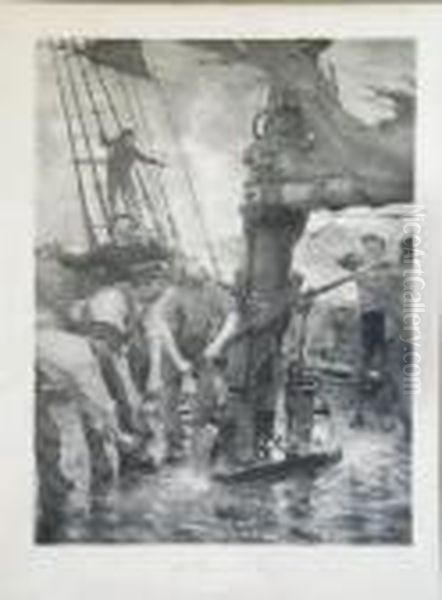
His plein air practice was fundamental. By painting directly outdoors, often from his boat or on the beaches near Falmouth, he could observe and translate the fleeting effects of light with immediacy. His brushwork became looser and more expressive than traditional academic painting, using broken colour and visible strokes to convey the vibrancy of the scene, akin to French Impressionists like Claude Monet or Pierre-Auguste Renoir, although Tuke generally maintained a greater degree of naturalistic representation.
He was proficient in both oil and watercolour. His oils often have a rich, luminous quality, built up with layers of paint to capture the intensity of sunlight. His watercolours possess a remarkable freshness and transparency, perfectly suited to depicting the fluidity of water and the ephemeral quality of light. Works like 'At Anchor' showcase his mastery of watercolour in rendering complex reflections and the atmosphere of the harbour. His palette was typically bright and high-keyed, emphasizing blues, greens, golds, and warm flesh tones.
Major Themes: The Male Nude
Undoubtedly, Henry Scott Tuke is best known for his paintings of nude or semi-nude boys and young men. This theme, pursued consistently throughout his mature career, sets him apart from most of his British contemporaries. His subjects were typically depicted bathing, swimming, lounging on rocks, or working on boats, always integrated into the natural coastal environment.
These works celebrate the youthful male form with an apparent directness and lack of classical pretext that was unusual for the era. While the male nude had a long tradition in Western art, it was often presented within mythological or historical contexts. Tuke’s nudes, by contrast, were contemporary figures engaged in everyday seaside activities. This naturalistic approach, combined with the palpable warmth and sensuality of his depictions, has led to interpretations of homoeroticism.
Tuke himself never explicitly addressed his sexuality, and direct evidence remains scarce. However, his focus on this subject matter, his close friendships with his models, and his connections to literary figures associated with the burgeoning gay subculture of the time (like the Uranian poets) strongly suggest a personal resonance. Regardless of his private life, these paintings stand as powerful explorations of youth, freedom, and the human body in harmony with nature, rendered with exceptional skill in capturing the play of light on flesh. Works like 'August Blue' and 'Ruby, Gold and Malachite' exemplify this central theme.
Major Themes: Maritime Subjects
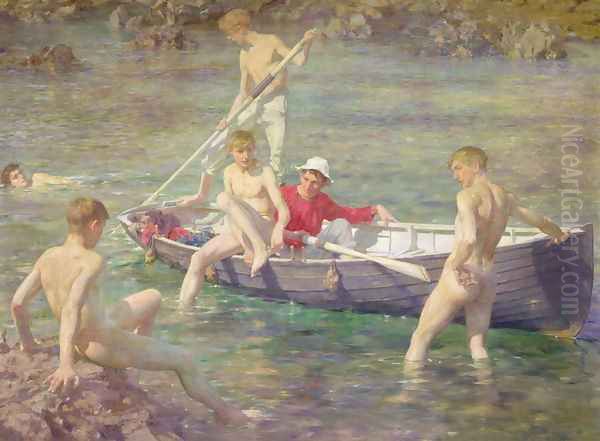
Beyond the male nude, Tuke possessed a deep and abiding passion for the sea and maritime life, reflecting his own enthusiasm for sailing. Falmouth, with its busy international harbour and local fishing fleet, provided endless inspiration. He painted numerous works depicting sailing ships, from majestic square-riggers to local fishing boats and yachts.
His maritime paintings demonstrate a keen understanding of nautical detail and the dynamic relationship between vessels and the elements. He captured the grace of ships under sail, the bustling activity of the harbour, and the atmospheric effects of sea mists and changing weather. Notable examples include his depictions of famous vessels like the 'Cutty Sark' and paintings capturing the working life of sailors and fishermen.
His painting 'All Hands to the Pumps!' (1888–89), purchased for the nation through the Chantrey Bequest, depicts a dramatic scene of sailors battling a storm. This work showcases his ability to handle complex compositions and convey narrative tension, demonstrating a range beyond his more idyllic scenes. His love for the sea was genuine; he was an active member of the Royal Cornwall Yacht Club and spent considerable time sailing, experiences that infused his maritime art with authenticity and vigour. He can be seen in the lineage of great British marine painters like J.M.W. Turner, though his style was distinctly modern.
Representative Works
Several paintings stand out as defining examples of Tuke's art:
'August Blue' (1893-94): Perhaps his most famous work, purchased by the Tate Gallery through the Chantrey Bequest in 1894. It depicts four nude youths bathing and lounging on a boat bathed in brilliant sunshine. The painting is a tour-de-force of Tuke's ability to render sunlight on water and flesh, capturing a sense of idyllic, youthful freedom. The vibrant blues of the sea and sky dominate the composition.
'All Hands to the Pumps!' (1888-89): Also acquired by the Chantrey Bequest, this painting shows Tuke's skill in depicting drama and action. Sailors struggle to pump water from their storm-battered vessel. It highlights his understanding of maritime life and his ability to create powerful narrative compositions, contrasting with his more serene nude studies.
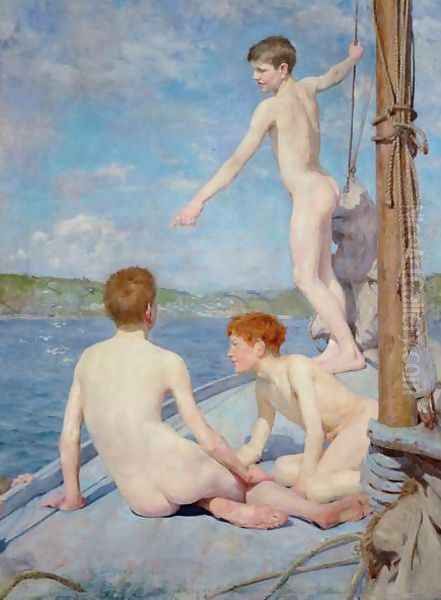
'Ruby, Gold and Malachite' (c. 1902): This work exemplifies his mature style in depicting the male nude outdoors. A single youth lies on colourful drapery spread over rocks by the sea. The title refers to the rich colours Tuke employs – the ruby reds and golds of the fabric and flesh tones against the malachite green of the sea. It showcases his bold use of colour and sensual rendering of the figure.
'The Bathers' (various versions): Tuke returned to the theme of bathers repeatedly. These works often feature groups of boys swimming or resting by the shore, allowing him to explore different compositions and light effects while focusing on his preferred subject matter.
'The Critics' (1927): A later work showing two older, clothed fishermen observing a yacht race. It demonstrates his continued engagement with maritime themes and local Falmouth life towards the end of his career, offering a different perspective from his youthful nudes.
These works, among many others, cemented Tuke's reputation for his unique blend of Impressionist technique, naturalistic observation, and his distinctive focus on youth and the Cornish coast.
Relationships and Influences
Tuke maintained a network of relationships within the art world and beyond. His teachers – Legros, Poynter, and Laurens – provided his foundational training. His encounter with Bastien-Lepage and Sargent in Paris significantly shaped his plein air approach and painterly technique. His association with the Newlyn School artists like Forbes, Langley, Gotch, Bramley, and Norman Garstin placed him within a key movement in British art, although his subject matter often diverged from their focus on fisherfolk's daily toil.
His relationships with his models were crucial. Many, like the boatman Charlie Mitchell, became long-term friends and appeared in numerous paintings over the years. These relationships seem to have been based on mutual respect and affection, providing Tuke with the consistent access needed for his studies. The identities of some regular models like 'Johnny' Jack Rolling (or Rowling) and 'Edward' Teddy Prynne have been documented through his meticulous diaries.
Tuke also moved in literary circles that intersected with emerging discussions around homosexuality. He was acquainted with figures like Oscar Wilde and maintained connections with writers sometimes labelled as 'Uranian' poets – individuals like John Addington Symonds and Charles Kains Jackson, who celebrated male youth and camaraderie, often with classical allusions. While Tuke was generally discreet, these connections provide context for the interpretations of his work. His father's circle in the medical and intellectual world also provided connections, such as his friendship with Thomas Dickens, son of the novelist Charles Dickens, whose portrait Tuke painted.
Controversies and Interpretations
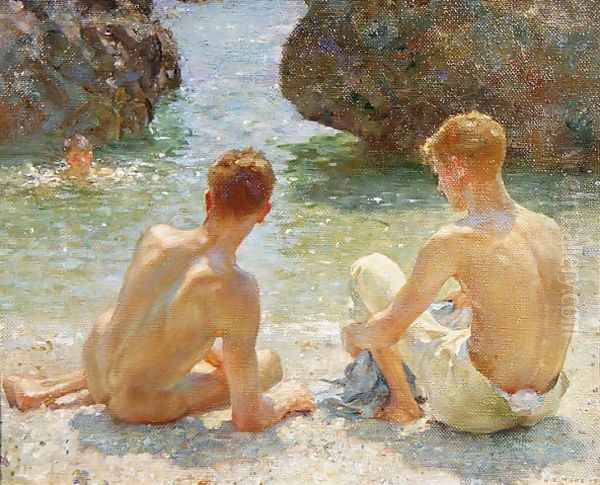
Tuke's focus on the male nude, particularly adolescent boys, inevitably attracted attention and, at times, controversy, both during his life and posthumously. In the socially conservative climate of late Victorian and Edwardian Britain, such direct depictions of contemporary nudes could be viewed with suspicion, differing significantly from the accepted classical or allegorical nudes of academic artists like Frederic Leighton or George Frederic Watts.
While Tuke achieved considerable success, including election as an Associate of the Royal Academy (ARA) in 1900 and a full Royal Academician (RA) in 1914, the underlying sensuality of his work was noted. Later, particularly from the 1970s onwards with the rise of gay liberation movements and LGBTQ+ studies, his work was enthusiastically rediscovered and reinterpreted. He became celebrated as a pioneering figure in queer art history, his paintings seen as coded expressions of same-sex desire and appreciation of the male form.
This interpretation, however, is not without its own complexities and recent challenges. In the 21st century, heightened awareness around child protection issues has led some to view Tuke's depictions of minors through a more critical lens. A notable instance occurred in 2010 when the Intercom Trust, an LGBT support group in South West England, removed Tuke's work from a planned LGBT history month exhibition, citing concerns about the potential for his paintings to be seen as exploitative or paedophilic in a modern context. This decision sparked considerable debate about historical context versus contemporary sensitivities, highlighting the ongoing dialogue surrounding Tuke's legacy. His work continues to occupy a space where aesthetic appreciation intersects with complex social and ethical considerations, perhaps comparable in its provocative nature (though different in style and intent) to the challenging works of artists like Egon Schiele.
Legacy and Historical Significance
Henry Scott Tuke left a significant mark on British art. He was a successful artist in his lifetime, exhibiting regularly at the Royal Academy from 1879 until his death and achieving the distinction of RA membership. His work was acquired by major public collections, including the Tate, through the influential Chantrey Bequest, signifying official recognition.
His primary contribution lies in his unique synthesis of Impressionist techniques with a distinctly British sensibility and subject matter. He masterfully captured the specific light and atmosphere of the Cornish coast and stands as one of the foremost painters associated with the region and the Newlyn School artistic colony. His dedication to plein air painting helped popularize the approach in Britain.
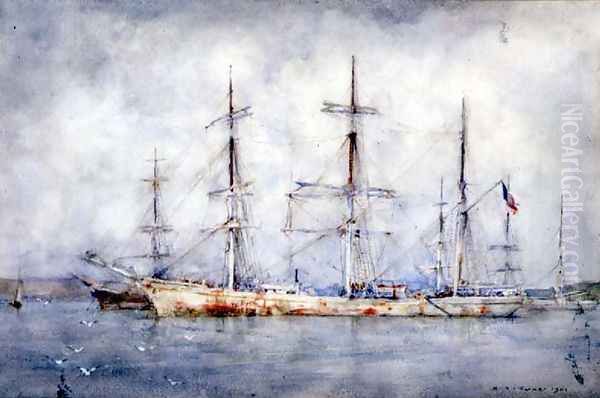
His legacy regarding the depiction of the male figure is particularly noteworthy. He approached the subject with a naturalism and sensuality that was rare in British art of the period. While initially falling somewhat out of fashion in the decades immediately following his death, his rediscovery in the late 20th century secured his position as a key figure for LGBTQ+ art history. His paintings offered affirmative images of male beauty and camaraderie that resonated deeply with later generations.
Today, Tuke's work is held in numerous public collections, including Tate Britain, the Royal Cornwall Museum in Truro (which holds a significant collection), and galleries across the UK and internationally. His paintings continue to be admired for their technical brilliance, their evocative portrayal of youth and the sea, and their complex position within the social and cultural history of his time. Like the Pre-Raphaelites (such as Dante Gabriel Rossetti or John Everett Millais) whose reputations also fluctuated, Tuke's work has found enduring appeal, securing his place as a distinctive and important voice in British art.
Conclusion
Henry Scott Tuke remains a fascinating and significant British artist. His mastery of light and colour, applied primarily to the coastal scenes of Cornwall and the youthful male figures who inhabited them, created a body of work that is both aesthetically captivating and historically resonant. As a member of the Newlyn School and an adopter of Impressionist principles, he contributed to the modernization of British painting. His unwavering focus on the male nude established a unique niche, leading to his later embrace as an important figure in LGBTQ+ cultural heritage. Despite ongoing discussions about the interpretation of his work, Tuke's paintings endure, celebrated for their vibrant depiction of sunlight, sea, and youth, securing his legacy as a distinctive chronicler of the Edwardian summer and the Cornish coast.